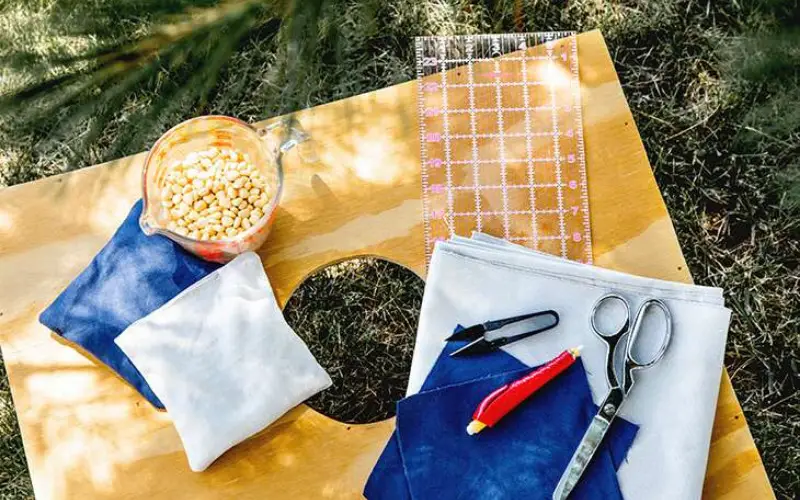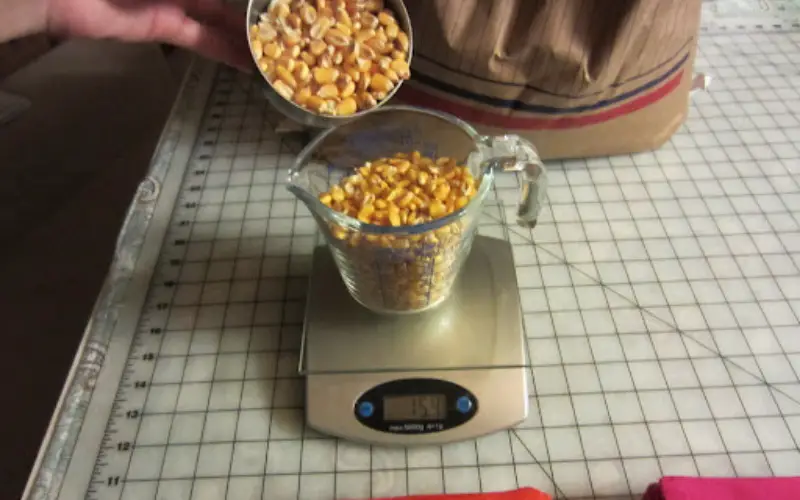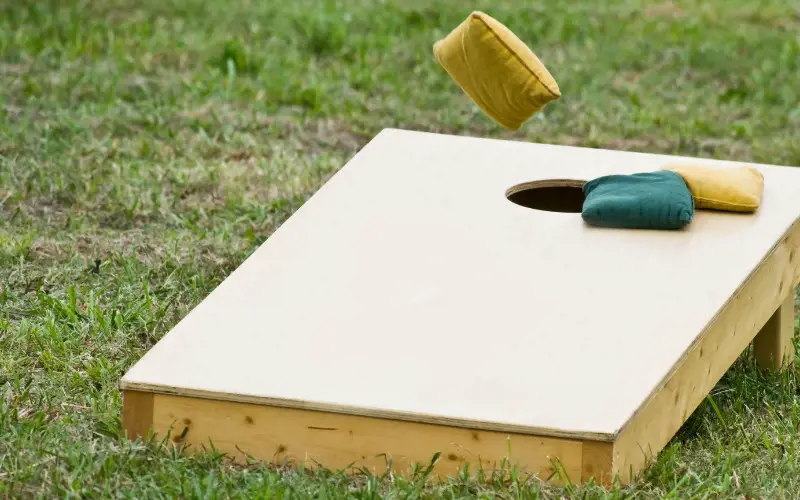In a game of cornhole, the bag is essential, and not just any bag will do; you have to use the right filling for a great game. A lot of materials can be used to fill as a cornhole bag, but there has been a constant debate in the cornhole community over using corn or pellets as a filling.
We will discuss the types of cornhole fillings, traditional cornhole fillings, and the most popular cornhole filling. We will also give precise steps on how to make a quality cornhole bag.
Choosing your Cornhole Bag
Choosing the right cornhole has is harder than you think. Different types of cornhole bags make it difficult because you have to choose one that matches your throwing style, so you must know the appropriate weight, size, and thickness of a good cornhole bag.
According to the American Cornhole League(ACL), the standard size of a cornhole bag should be 6” × 6” inches, and the standard weight should be between 15.5 oz to 16 Oz.
When choosing a filling for your cornhole bag, you should note that good filling is decay resistant, weather-resistant, washable, affordable, and pest resistant.
The Best Cornhole Bag Filling

A plastic resin is the best filling with all of the materials that can fill a cornhole bag.
Plastic resin possesses all the qualities of a good filling and puts you in comfort when you throw.
It has a capsule-like shape or a pellet shape; for professional cornhole players, it has been stated by the American cornhole League(ACL
It is hard to be comfortable if your cornhole bag attracts insects and bugs; that is why a lot of people opt for plastic resin because they are pest resistant.
Plastic resins are more durable than other cornhole bag fillings, they don’t grow mold like some fillings, but they are hygroscopic and absorb moisture.
If your bag is overstuffed with plastic resins, it tends to bounce more, but a good board will help with that problem.
One of the disadvantages of plastic resins is that they are more pricey than other fillings, so some people go for alternatives to save money.
You should keep these pellets far away from your kids and pet to prevent them from swallowing these fillings.
Traditional Cornhole Filling
A naturalist may prefer a cornhole bag filled with corn kernels. Corn kernels can be found cheap in your local food store; they should be dried before being stuffed inside a cornhole bag. Just like the plastic resin pellets, corn kennels have their advantages, and it’s drawbacks.
Your corn will get broken down after being used for a long time; because of this, corn kennels are poorly rated when it comes to durability. It also rots and grows mold when in contact with moisture or because of bad weather conditions.
Corn kennels also attract mildew, critters, and insects, especially when left outside in a wet condition. This can make your corn go bad and begin to smell, and just so you know, it is never fun tossing a smelly cornhole bag.
Sometimes there is a shortage of corn, so it may not be easy to get your hand on corn; when in contact with water, your corn can swell, making your bag heavy.
The disadvantages of using corn kernels as fillings are more than its advantage; this makes corn kennels a bad filling for a cornhole bag. But some players love the authenticity of using corn kernels, so they opt for it.
Other types of stuffing are used to fill cornhole bags.
Apart from corn kennels and plastic resin pellets, other materials can be used to stuff your cornhole bag, so you are not limited to just these two options.
These materials include sand, dry peas, and even beans.
These materials can be gotten easily from a local store; if they are your alternatives, you should use dry sand as wet sand is heavier.
These other materials are suitable for use if you are playing cornhole for leisure in your yard. This is because, for championships and tournaments, you will be restricted to one or two filling materials. For the ACL, you are only allowed to use a bag filled with plastic resin pellets.
Most Popular Cornhole Bag Filling
Some people choose which cornhole bag to purchase based on its popularity. The most popular cornhole bag filling is synthetic corn pellets. This filling is great for both naturalists and people who target quality.
Synthetic corn pellets are pellets that are shaped like dried corn kennels. So players get that natural corn sensation while maintaining quality.
These synthetic corn pellets can be found at an affordable price on Amazon, but some might not be shaped like corn kernels after being ordered.
Regulation Cornhole Bag Filling
If you are going pro in cornhole, knowing what type of cornhole bags get approved is important. According to the American Cornhole Organization ACO, an approved cornhole bag should measure 5.7 inches by 5.7 inches and should not exceed 8.25 inches from corner to corner.
An approved bag should weigh between 15.75 ounces (447g) and 16.25 ounces (461g), and when flat, a cornhole bag should have a thickness of 1.125 inches (3.18cm) but should not exceed 1.5 inches (3.8cm), and each bag should be filled with plastic resins that will not break down.
And according to the American Cornhole League, the standard size of a cornhole bag should be 6 inches by 6 inches, and it should have a weight of 15.5 ounces to 16.25 ounces, and the thickness of your cornhole bag should not be less than 1.125 inches, and it should not be greater than 1.5 inches. The required bag filling by the ACL is a plastic resin, so a corn bag can be used but only for a fun game of cornhole.
How Much Filler Do You Put in Cornhole Bags?

Filling your cornhole bag with just the right amount of plastic resin or corn kernel is essential. You do not want your bag too heavy, and a light cornhole bag will not go far.
Experts recommend using two cups of plastic resin or corn kernel. Each cup should weigh about 7 ounces to 7.5 ounces; following this measurement, you will get the standard weight of a cornhole bag, according to cornhole organizations.
How Do You Make Quality Cornhole Bags?
A quality cornhole bag is made of a strong cotton material called duck. This material is durable, and in modern times it is often paired with microfiber.
This means that one side of a cornhole bag is made of a duck while the other is microfiber. This feature allows your bag to slide freely or come to a sudden stop.
A cornhole bag made of a soft material may tear easily, and of course, you can sew it back since a torn bag cannot be used to play, but it is recommended that you purchase a new cornhole bag made of duck or microfiber.
How Do You Hand Sew Cornhole Bags?
One good thing about cornhole bags is that they can be made easily at home. There may be no need to purchase a cornhole bag if you possess sewing skills and the supplies needed. To hand see this bag, you will need,
- 15” × 30” duck cloth
- Needle and thread, scissors, and stitch glue.
- Corn kernel or plastic resins
After gathering your materials, the following steps should help you hand see a cornhole bag successfully.
- Put your duck cloth on a smooth surface and measure out 8 inches on all sides of your material using a pencil.
- Cut out the measured square with scissors and align the cut-out materials together.
- Use pins to hold the material in place, and then you can proceed with stitching. Note that the box being stitched should measure up to 6 inches; this leaves two extra inches out.
- You should note that during stitching, only three sides should be closed. One side should be left open for the entry of your corn.
- Use a stitch glue to make your work solid
- After sewing, cut out the extra material and turn your work inside out, making your bag look exactly 6 inches in size.
- Fill your bag with 15 ounces of corn, plastic resins, or whatever filling you have available.
- Glue the last side and stitch it up. Be sure to double or triple stitch the final side to prevent your fillings from leaking out.
Conclusion
A game of cornhole will not be played properly if your bags are the wrong size or if they have been filled with the wrong materials.
The best material to use for filling a cornhole bag is plastic resin pellets. We have discussed its advantages and disadvantages, along with corn kernels.
It is also crucial that you take note of the standard measurement of a cornhole bag. The appropriate size, weight, thickness, and amount of filling have been provided above.
You can also hand sew a cornhole bag using the durable duck material; this information is necessary to make accurate shots during a game.
Helpful Links:
- What Are Most Cornhole Bag Filled With?
- Maggift Kubb Game Reviews and Buying Guide
- Razor Pogo Stick Review – Top 5 Best Pogo Sticks
- How To Install A Tetherball Pole In The Ground
We trust this article helped you know the materials that make the best cornhole bag filling. You may also want to check out How Do You Put LED Lights in Cornhole? (6 Quick Ways).
Thanks for taking the time to read our article, and we hope you find it helpful. Would you mind leaving a comment below if you have any suggestions?
Kindly reach out to people by sharing this post on social media.
If you liked this article, then please follow us on Facebook, Instagram, and Pinterest.
Cheers!
www.backyardcaring.com
Materials That Make The Best Cornhole Bag Filling

